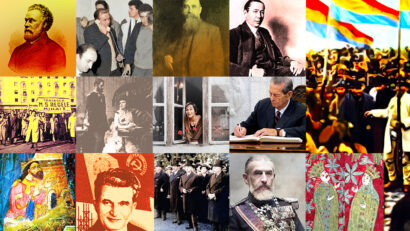The Romanian Communist Party
For over 40 years, between 1945 and 1989, Romanians used to mark on May 8th the communist party day.

Steliu Lambru, 17.05.2021, 13:09
The communists had been ruling Romania with an iron hand since March 6, 1945, with the direct involvement of the Soviet Union. According to the communist propaganda, the Romanian Communist Party had the great duty of accomplishing the highest social, economic and political ideals and making Romanians happy. Reality, however, was anything but great. The communist regime proved to be highly repressive and lacking economic vision. The state seized private property, cancelled political rights and imprisoned its opponents. In 1989, in the Central and East European countries, communist regimes fell and the societies traumatized by them could finally start going back to normal.
The emergence of the Romanian Communist Party 100 years ago was prompted by the Third International in Moscow. It was a decision of the Socialist Party in Romania to join the International, decision taken by vote on May 11, 1921, a moment subsequently regarded as the first congress of the Romanian Communist Party (PCR). Until the second congress, held in October 1922, this party was called the Socialist-Communist Party. As of 1922, its name was the Communist Party of Romania, a section of the Third Communist International. The partys activity was, since the very beginning, directed against the Romanian state, which led to its banning in 1924.
Historian Ioan Scurtu tells us more about the importance of the First World War for the emergence of the communist radicalism: ”During the war, the population, workers included, had a very hard life. For this reason, in Europe and elsewhere, a radical socialist movement developed, which became communist, a process that also took place in Romania. It started from the idea of meeting the demands of the working class, but its agenda later included the idea of taking over political power by all means. Instating the dictatorship of the proletariat became its goal and the main characteristic of communist parties. Up until that moment, all parties, including the social democratic and socialist parties, wanted to take over power by vote, by winning the elections. This time, however, they planned a revolution to help them seize power and impose the dictatorship of the proletariat and nationalize the main production means, so a radical change of society. ”
At the beginning of October 1920, a delegation of the Socialist Party in Romania led by the partys general secretary, Gheorghe Cristescu, traveled to Moscow to discuss the partys affiliation with the Communist International or the Third International as it was also called. On December 9, the delegation accepted to sign unconditional affiliation, but the leaders of the International, Zinoviev and Buharin did not accept the idea of having, among the leaders of the party to be affiliated, the socialists who, on December 1st 1918, voted in Alba Iulia the unification of Transylvania with Romania. This led to a split within the Romanian socialist movement.
Ioan Scurtu: ”Zinoviev and Buharin specifically asked for the removal, from the Romanian delegation, of Ion Flueras, who had been a member of the Great Assembly in Alba Iulia. This type of radicalism was already manifesting itself since 1920s and, in the meeting of January 30 – February 3rd 1921, when the Romanian delegation presented their activity report in Moscow, it was decided that the members considered to be right-wing sympathizers and nationalists, be expelled from the party for they were not revolutionaries and were likely to take the side of the bourgeoisie. That was the moment when the communist, radical group, took over the leadership of the Socialist Party. That is why the congress had no problem voting the affiliation to the Third Communist International.”
During the entire inter-war period, the Romanian Communist Party was an insignificant party. Ioan Scurtu tells us why: ”The most serious problem that affected the partys capacity to win Romanians over, the electorate in particular, was that, at the Cominterns demand, it accepted the slogan of self-determination up to the separation from the Romanian state of the historical provinces united with Romania in 1918. It was also specified that Bessarabia, Bukovina and Transylvania were the provinces in question. The province of Dobruja was also included, following the pressure of Bulgarian communists, who had a role in the leadership of the Third International. The fact that Romanians fought in the First World War precisely for unification, made it impossible for the communist party to win adherents.”
At the end of the Second World War, the insignificant and blood thirsty-party took the helm of Romania. But that was only possible with the consent of the United States and Britain, as Ioan Scurtu explains: ”It is a certainty that the communist party seized power in Romania due to the direct intervention of the Soviet envoys. But that was only possible with the direct contribution of the US President and the British PM. They are the ones who accepted Stalins demand that, at the borders of the USSR should not be governs that are hostile to the Soviet state. For Stalin, not being hostile meant being subordinated and a friend country meant an occupied country. ”
The Romanians paid a heavy price for it and lived under the burden of communism for more than 40 years.






























